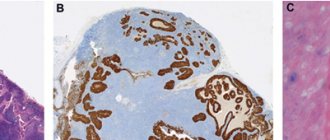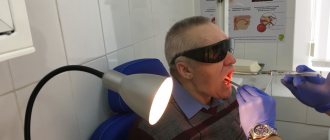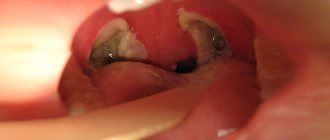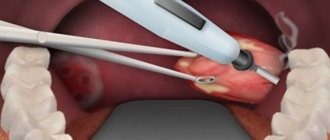For every parent, there is nothing worse than a child’s illness. I would like to help in any way possible. One of the common pathologies is chronic tonsillitis - inflammation of the pharyngeal tonsils. The main reason for its occurrence is weakened immunity.
It is less common in children under 3 years of age; children from 3 to 12 years of age are most susceptible. If you suspect such a disease in your child, it is worth making an appointment with a pediatric ENT specialist, as untimely treatment can lead to unpleasant complications.
The concept of “loose tonsils”
The tonsils or tonsils are located behind the palatine arches and create a protective barrier against bacteria and germs. In normal condition they are almost invisible. If the inflammatory process develops, they begin to increase in size and become swollen and convex.
This occurs due to inflammation of the lymphoid tissue, which is the first to encounter the harmful effects of pathogenic microorganisms.
Loose tonsils can occur in the following cases:
- the beginning of the acute phase of the disease (ARVI, tonsillitis, pharyngitis and other diseases);
- chronic form of throat diseases;
- as a residual phenomenon after severe infectious diseases (angina, scarlet fever and others).
Loose tonsils require some care, as food debris gets stuck in them, which is an excellent flora for the proliferation of bacteria and the development of inflammatory processes.
Main causes
If you notice loose tonsils in a child, which clearly stand out with their rounded shapes, you should not panic and buy all the pharmaceutical drugs intended for the treatment of throat diseases. This condition indicates the onset of the development of the inflammatory process.
The tonsils began to form local protection so that the pathogenic microbes that got on them did not penetrate further into the body.
Interesting: in young children, the tonsils produce special enzymes that help break down food in the mouth.
The main culprit of looseness is a change in the functioning of the gland on the tonsils. In certain cases, the tonsils cannot cope with the effects of external infections. To fight microbes, a large number of lymphocytes are produced, but they are not always enough. As a result, painful processes begin to develop in the throat and nasopharynx.
There are several main reasons for the appearance of loose tonsils.
Entry of pathogenic viruses or bacteria into the oral cavity and nasopharynx. The production of plasmacides, microphages and lymphocytes begins in the follicles and lacunae. If the immune defense fails, the development of diseases such as tonsillitis, pharyngitis and others begins.
A decrease in the child’s immunity after suffering from infectious diseases as a result of the glands on the tonsils does not work correctly and the tonsils remain voluminous and loose.
Severe hypothermia or cold.
A residual phenomenon after suffering from acute respiratory viral infections or acute respiratory infections.
The presence of chronic diseases in the oral cavity (carious tooth decay, periodontitis, long-lasting wounds, etc.). The lymphatic system has to regularly suppress pathogenic microflora, which results in swelling of the tonsils.
In the case of frequent severe throat diseases, especially sore throats, damage to the lymphoid tissue begins as a result of which the mucous surface of the tonsils remains deformed forever.
How to treat chronic tonsillitis?
In this case, treatment should only take place under the supervision of a doctor. Its necessity is due to the fact that tonsillitis depletes the child’s immunity, and if treatment is not completed, it can worsen and lead to various kinds of complications: kidney disease, heart pathology, bronchitis, psoriasis, and diseases of other ENT organs.
Several ENT treatment options are possible; the doctor will determine the appropriate one after examining the child. In some cases, you will need to take a general analysis of ESR - erythrocyte sedimentation rate, which will allow you to identify the infection even in a latent form and begin treatment immediately.
To cure chronic tonsillitis, one of 2 treatment options is used: conservative or surgical.
The first involves taking antibacterial, antiviral, and antihistamine drugs. Local antiseptics and homeopathy and physiotherapeutic procedures (UVR, electrophoresis) are also prescribed.
Indications for surgery are frequent sore throats, purulent inflammations, lesions of other organs that arise against the background of tonsillitis. If based on all the symptoms you believe that your child has this disease, contact a specialist. The medical office is attended by an experienced doctor who diagnoses the disease and prescribes effective treatment, and gives recommendations for the prevention of chronic tonsillitis. The clinic also offers tests for children and adults and receives quick results by email. To make an appointment, use the convenient form on the website or the hotline number +7 (863) 333-20-11
Symptoms
Loose tonsils are a consequence of the development of the inflammatory process as a result of a variety of reasons. This in itself is not a disease, but its manifestation. Doctors do not diagnose “loose throat” - this is a visual manifestation of a concomitant illness. In addition, the following signs of the disease can be observed:
- Painful sensations when swallowing food and liquid.
- Deviation of body temperature from normal. In this case, the temperature can be either very high or not exceed the threshold of 37.3 degrees.
- Headache as a result of the toxicological effects of the breakdown of waste products of pathogenic microorganisms.
- General malaise. Lethargy, fatigue, weakness, body aches are a consequence of the development of infectious processes in the body.
- Hoarse voice. Appears after infection penetrates the vocal cords.
- Painful sensations and enlargement of the submandibular and cervical lymph nodes.
- External changes. Red throat, pronounced vascular network, protruding palatine tonsils, rashes on the tonsils, larynx and palate.
And also an unpleasant smell. In the absence of dental problems, this smell indicates the process of decomposition of lumps of food stuck on the surface of the tonsils. If food debris is not removed in time, inflammation of the lymphoid tissue is guaranteed.
Do not assume that such signs can appear at the same time. The presence of an inflammatory process in lymphoid tissue may be indicated by the presence of one or two symptoms.
Many dangerous and insidious throat diseases are difficult to recognize. Self-medication can lead to serious consequences for the body, as well as the development of chronic diseases.
Treatment methods
Complex treatment of loose tonsils is based on identifying the cause of the pathology. In most cases, the appropriate therapy is prescribed by a doctor.
It is possible that to make a correct diagnosis you will need a laboratory blood test, a smear or scraping from the larynx and tonsils.
Collection of material is necessary to determine the sensitivity of pathogenic bacteria to a particular group of antibiotics.
Next, the doctor will take into account the general condition of the child, his age and the severity of the disease.
If a bacterial infection is detected, the following complex action is applied:
- Taking antibiotics. The drug, dosage and duration of use are determined only by the doctor.
- Use of anti-inflammatory sprays and tablets.
- Gargling with decoctions of medicinal herbs, medical compositions.
- Taking vitamins.
- Warm drink.
- Bed rest.
For a speedy recovery, physiotherapy may be prescribed:
- quartz;
- ultrasound;
- inhalation;
- magnetotherapy.
The presence of a common cold or viral infection requires adequate therapy, since untreated can result in pharyngitis or sore throat. Warm drinking, rinsing, taking antiviral drugs, and frequent ventilation of the room will help avoid complications.
In the absence of pain in the throat and accompanying signs of the disease: fever, cough, rash on the tonsils. It is important to monitor oral hygiene and prevent the development of inflammatory processes. You should wash the child’s nose and mouth with specialized solutions and sprays, spend more time in the fresh air and moisten the room.
When should you wash your tonsils?
The fact is that pathogenic microorganisms and dead leukocytes not only accumulate inside the tonsils, but they also cannot leave their location, since inside the tonsils there are many voids and tortuous “passages”. If you influence them with the same drug, then sooner or later addiction occurs - microorganisms (streptococci and staphylococci) become resistant, adapt to the antibiotic, and it is no longer powerless to cope with them. This is where a special procedure comes to the rescue - washing the tonsils.
Washing the tonsils is prescribed to a person who has long suffered from chronic tonsillitis with constant exacerbations, who feels constant weakness, soreness in the throat, in the cervical and submandibular lymph nodes.
Types of cleaning loose tonsils
To prevent the occurrence of inflammatory processes in loose tonsils, they should be cleaned regularly. Deeper cleansing is performed in a medical facility.
In the case of small children, such manipulation at home is unacceptable. The child undergoes ultrasound treatment. And then, using a special syringe, the entire larynx is irrigated. This allows you to remove food debris, plaque and pathogenic microorganisms from the tonsils. The procedure is carried out at least 10 times both as treatment and prevention of diseases.
For older children, you can use the following methods to clean the tonsils:
- We ask the child to open his mouth wide. Use the convex side of a teaspoon to press on one of the tonsils.
- The exposure is carried out until whitish discharge appears in their lacunae.
- The child should gargle thoroughly with a solution of sea salt.
- We perform the same action with the second amygdala.
Such cleaning can be carried out not only during illness, but also for its prevention.
Therapy and prevention
Young children are more likely to suffer from various throat diseases than adults. If a child has a tendency to develop inflammatory processes in the tonsils, parents can take the following preventive measures:
- Strictly monitor oral hygiene. Brushing your teeth at least twice a day. Rinse your mouth with regular boiled water after each meal.
- Timely treatment of all dental problems. Carious bacteria can cause constant swelling of the tonsils.
- Home or medical rinsing of lacunae. This can be done independently by gargling with a solution of furatsilin or with an antiseptic.
- Gargling the throat with decoctions of medicinal herbs: chamomile, calendula, sage. It is recommended to alternate herbs.
If treatment and prevention do not produce the desired effect, the doctor may decide to remove the tonsils. This is done in the following cases:
- Severe sore throats 5 or more times a year.
- Therapy, treatment and cleaning do not bring any results.
- Irreversible changes in lymphoid tissue, in which the tonsils cease to perform a protective function.
- Pathological growth of the tonsils, which negatively affects the respiratory tract and hearing organs.
Surgery is indicated only in very severe cases. This is an extreme measure that deprives the child of the initial protective barrier. After removal of the tonsils, the infection will directly enter the upper respiratory tract and provoke diseases.
In order to avoid the need for extreme measures, you need to be attentive to the child’s health. Do not self-medicate, spend more time in the fresh air, playing outdoor games and harden your throat.
Your child is undergoing surgery. We would like to give you and your child information about the need for this intervention. We make sure that you do not feel helpless in this situation. We would like to acquaint you with the essential aspects of the operation itself, and the risk factors in case of its failure. The written information provided to you serves this purpose. Read it carefully to discuss any unclear points with your doctor.
Every healthy child has lymphoid tissue in the pharynx, which is united into the so-called lymphadenoid pharyngeal ring. It includes the palatine tonsils - “tonsils” - they can be seen when examining the mouth - they look like balls protruding on the sides of the tongue, the pharyngeal tonsil - it cannot be seen during a direct examination of the oral cavity, it hides in the nasopharynx, behind the palate, lingual tonsil - located at the root of the tongue, and many lymphoid follicles scattered along the back wall of the pharynx, at the entrance to the larynx (see Fig. 18). These formations help the child defeat pathogenic bacteria that enter the throat during breathing and eating, and contribute to the formation of local immunity - protection against pathogens. By the way, in these organs there are no cells that affect the sexual development of the child, they do not produce sex hormones, therefore their diseases do not affect the sexual development of the child, and if they are removed if necessary (more on this later), sexual development is not disrupted.
In early childhood - usually from 2 to 5-7 years - the described organs work very hard, as the child expands the scope of contacts with peers by attending kindergarten, and inevitably often becomes infected and develops respiratory diseases. Moreover, if the child’s immune forces are not strong enough due to congenital characteristics, environmental factors and other reasons, the lymphoid organs increase in volume. This enlargement of the palatine tonsils is called “hypertrophy of the palatine tonsils”; they can become inflamed - inflammation of the tonsils is called tonsillitis. Tonsillitis can be acute or chronic. In children, chronic tonsillitis and adenoids - an enlarged pharyngeal tonsil - are often combined.
The tonsils of the pharynx have a significant impact on the state of health and the development of nearby organs. What kind of influence is this? A noticeable obstruction to the passage of air through the nose leads to breathing through the mouth. The consequence is obvious - untreated air enters the respiratory tract - not purified, not warmed and not humidified. A chronic inflammatory process, constantly smoldering in the tissue of the tonsils and adenoids, periodically exacerbating, contributes to protracted, recurrent diseases of the trachea and bronchi (bronchitis, obstructive bronchitis, tracheitis, pharyngitis), can independently cause or aggravate the course of allergies, in severe cases manifested in the form of bronchial asthma , allergic rhinopathy, atopic dermatitis. Adenoids and enlarged palatine tonsils, filling the pharynx, impair the functioning of the auditory tubes, which cannot supply sufficient air to the middle ear, as a result of which secretory otitis media develops, which can lead to hearing loss, and if infection enters the ear, to its acute inflammation – acute purulent otitis media. Poor breathing through the nose contributes to improper development of the maxillofacial area - the bite of the teeth is disrupted, the shape of the face changes (the so-called “adenoid face”).
The causative agents of infectious diseases of the respiratory tract (most often streptococci) after a sore throat remain in the palatine tonsils, and their chronic inflammation develops - chronic tonsillitis. Under unfavorable circumstances (hypothermia, stress, viral infection), the process in the tonsils is activated. This occurs in the form of another sore throat with plaque on the tonsils or purulent plugs. What is very dangerous is that each exacerbation of tonsillitis can cause complications in the form of diseases of other organs and systems of the child’s body, most often rheumatic diseases of the heart and joints, kidney diseases (pyelitis, pyelonephritis, glomerulonephritis). In addition, exacerbation of tonsillitis or tonsillitis sometimes causes complications in the form of an abscess (ulcer) in the pharynx. This complication is called peritonsillar abscess. A peritonsillar abscess indicates that the palatine tonsil is unable to cope with its function; it can recur at any time.
What factors contribute to enlargement of the pharyngeal tonsils and the development of chronic tonsillitis?
- Heredity - at least if the parents suffered from adenoids or tonsillitis, the child, to one degree or another, will also face this problem.
- Inflammatory diseases of the nose, throat, pharynx - and respiratory viral infections, and measles, and whooping cough, and scarlet fever, and tonsillitis, etc.
- Eating disorders - especially overfeeding.
- Tendency to allergic reactions, congenital and acquired immunity deficiency.
- Violations of the optimal properties of the air that the child breathes - very warm, very dry, a lot of dust, an admixture of harmful substances (ecological conditions, excess household chemicals).
- Inadequate (incorrect) treatment of acute tonsillitis (tonsillitis). The most common mistakes are an incomplete course of antibiotic treatment, incorrect dosing, violation of the therapeutic and protective regime (early getting out of bed, walking outside before 7-10 days from the start of treatment).
Thus, the actions of parents aimed at preventing chronic tonsillitis come down to correction, and even better, to the initial organization of a lifestyle that promotes the normal functioning of the immune system - feeding according to appetite, physical activity, hardening, limiting contact with dust and household chemicals.
What is the difference between chronic tonsillitis and tonsil hypertrophy?
Hypertrophy of the tonsils is an increase in their size in the age of a child up to 9-10 years. With chronic tonsillitis, the tonsils can be of any size; its distinctive feature is the development of a chronic inflammatory process in the tonsils.
What if a child, along with chronic tonsillitis or enlarged tonsils, has adenoids?
The presence of adenoids and difficulty in nasal breathing significantly influence the development of tonsil disease. In this case, otolaryngologists suggest that in the case of a compensated form of tonsillitis, while preserving the palatine tonsils, it is necessary to remove the adenoids, and in the case of a decompensated form, include adenotomy in the scope of the operation to remove the palatine tonsils, which slightly lengthens the operation and is almost imperceptible to the patient, but greatly affects the result of the operation. If this is not done, the child has a high probability of progression of tonsillitis or adenoiditis, which will negate the results of tonsillectomy - difficult nasal breathing will persist, the child will again become ill often, snoring will not go away or will worsen.
When is tonsillitis treated and when is surgery performed?
There are two forms of chronic tonsillitis: compensated and decompensated. In the decompensated form, surgical treatment is not possible - the tonsils must be removed. This diagnosis is made when tonsillitis often worsens (2-3 sore throats per year), the process extends beyond the tonsils, if diseases of distant organs and systems develop, for example, nephritis, rheumatic diseases of the heart and joints. Tonsils must be removed if a peritonsillar abscess develops.
Is it possible and necessary to treat chronic tonsillitis?
Let us emphasize that treatment is not only possible, but also necessary. Until the child develops the changes mentioned earlier, every six months, local treatment should be carried out in the form of irrigation of the pharyngeal mucosa with aqueous solutions that have anti-inflammatory, antiallergic and antimicrobial properties, as well as general treatment methods, including vitamin preparations, agents that affect immune system, locally acting vaccine preparations, physiotherapeutic methods (magnetic and laser therapy, inhalations). Otolaryngologists consider it particularly important in the treatment of tonsillitis to conduct a course of washing the lacunae of the palatine tonsils (7-10 procedures per course of treatment).
How urgently should the operation be performed?
The operation to remove the tonsils - tonsillectomy - is planned, that is, it is performed when the child is in full health or in remission of chronic diseases. It cannot be performed during acute illnesses (ARI) and 3-4 weeks after recovery. Thus, it is always possible to perform this operation in a period favorable for the child, which will minimize the risk of postoperative complications.
Do palatine tonsils grow again, are relapses possible?
No, completely removed tonsils cannot grow back.
How are tonsils removed?
This operation is performed using local or general anesthesia (narcosis). It lasts 25-30 minutes and, with proper psychological preparation of the child, is tolerated satisfactorily. The simplicity of the operation does not indicate its safety. Complications due to anesthesia, bleeding, and damage to the palate are also possible. But all this does not happen often.
Surgeons have long abandoned the removal of tonsils using ultrasound and laser due to the huge risk of complications.
How long does a child stay in the hospital after surgery?
Due to the high risk of bleeding in the postoperative period, the child is in the hospital for 6 days after surgery.
What should you do after your baby is discharged?
The child is discharged from the hospital under the supervision of an ENT doctor or pediatrician at the clinic at the place of residence. Home treatment is usually recommended for 1-2 weeks. In this case, physical activity should be limited, however, there is no need to keep the child in bed. When eating during the first days, you should not eat hot, spicy foods, sour juices and fruits, carbonated drinks, or ice cream. After 5-7 days, the diet becomes normal. 10-14 days after discharge, if the child’s general condition is satisfactory, there is no elevated body temperature, and the wound in the pharynx is healing smoothly, you can visit the children’s group and go outside. You can’t just do sports or go to the pool. The wound in the pharynx heals completely in 3-4 weeks. A month after the operation, there are no restrictions in lifestyle or diet.
How to remove tonsils at the Children's City ENT Center?
To establish a diagnosis, if there is no ENT doctor in the clinic, you can make an appointment at the city ENT consultation office by calling 2-78-49-00 (inquiry).
Reception is carried out on weekdays, from 8.00. until 20.00.
If the diagnosis of “chronic tonsillitis” has been established and you have made the decision to operate on your child, with a referral for surgical treatment issued at the clinic, you should go to the emergency department of the 3rd Children’s Clinical Hospital at any time convenient for you. Your child will be registered for hospitalization on the day you choose and will be given an examination plan (a list of tests necessary to perform the operation). Hospitalization is carried out on Tuesday and Thursday, from 13.00. until 15.00. and on Sunday from 16.00. until 18.00. The operation is carried out the next day.








